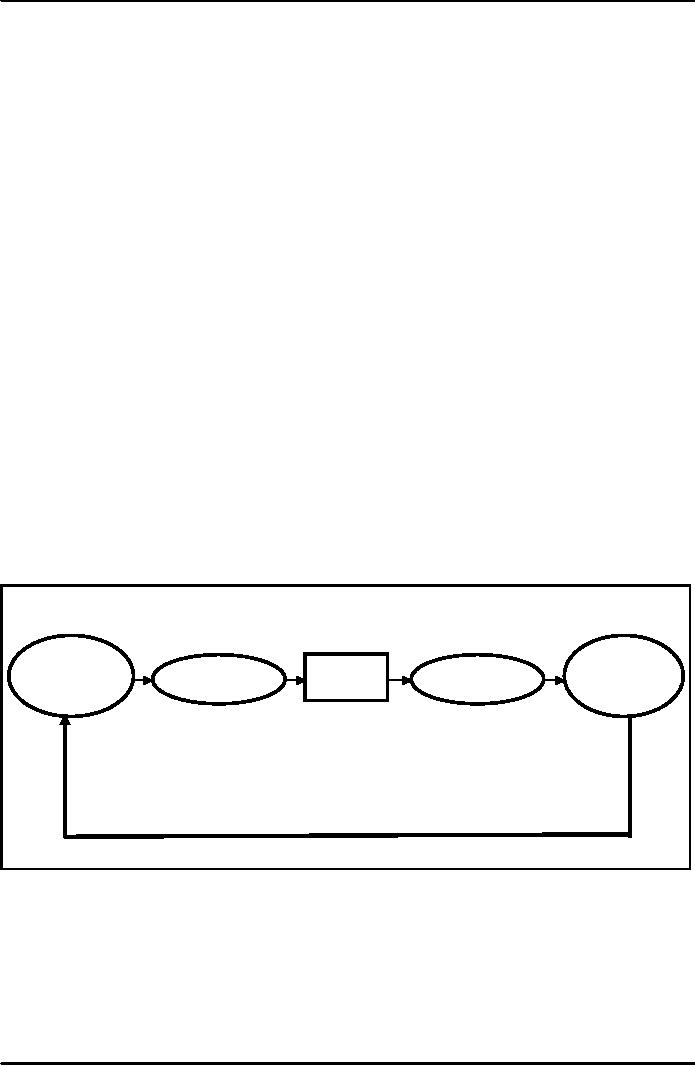 |

Introduction
To Public
AdministrationMGT111
VU
LESSON
37
COMMUNICATION
I
At the
end of the lecture students
will be able to:
-
Understand
the process of communication;
-
Understand
what is effective communication and
-
Understand
barriers to communication in organization.
The
Communication Process
In
our every day life we
are communicating or sharing information
and ideas. Sometimes
we
understand
what the other person is saying
sometimes we misunderstand. And
misunderstanding can
lead
to
differences, conflict or grievances
etc. How communication affects
our life and working in
organizations
is
explained through example:
Example:
Most of us are familiar with
the game of "telephone," in which
one person whispers a
message
into the ear of another, who
whispers the message to the next
person, and so on.
Inevitably, when
the
last person says the message
out loud, it is quite
different from what was
first whispered in the ear
of
first
person.
This
example of "Telephone" illustrates
numerous complexities in the communication process.
We
will
highlight three such
complexities in the communications model
which will be presented to you.
In
figure
1 we have tried to show that
(1) communication takes place in
relationship between a sender and
a
receiver,
(2) communication can flow in
one direction and end
there and (3) message
can elicit a response
which
is formally known as feedback-from the
receiver. What do we interpret
from the figure? The figure
is
explaining
to us that in a simple flow
(transmission) of information from
one person to another person, it
is
the
feedback which tells us if
message is correctly received or not
.
A
Model of Communication
Figure
1
Transmit
Message
Message
Receive
Sender
Receiver
Encoding
Encoding
Channe
(Source)
(Target)
Noise
Transmit
Feedback
Receive
We
must remember we are being
flooded with communication everyday, when
we watch
advertisements
on T.V., boards etc. All
advertisement is sending out
messages of different kinds and we
are
being
bombarded with information.
We
will now see each component of the
figure separately:
132

Introduction
To Public
AdministrationMGT111
VU
The
sender
The
sender (source of the message) initiates
the communication with some purpose. In
an
organization,
the sender will be a person
with purpose for communicating
message or instruction to one
or
more
people in organization.
The
Receiver
The
receiver is a person whose
senses perceive the sender's
message. The message can be
in words
,
symbol, gesture etc. There
may be a large number of receivers, or
there may be just one.
The message must
be
crafted or designed with
receiver's background in mind.
Encoding
Encoding
takes place when the sender
translates the information to be transmitted
into a series of
words,
symbols etc. Encoding is
necessary because information
can only be transferred from
one person to
another
through representations of words or
symbols etc.
Decoding
Decoding
is the process by which the receiver
interprets the message and translates it
into
meaningful
information. It is a two-step process.
The receiver must first
perceive the message and
then
interpret
it. Decoding is affected by the
receiver's past experience, knowledge,
position in organization etc.
Noise
Noise
is any factor that disturbs,
confuses, or otherwise interferes
with communication. Noise
can
arise
along what is called the communications
channel, or method of transmission
(such as air for
spoken
words
or paper for letters) or external or
internal (as when a receiver
is not paying attention). Noise
can
also
be referred to as "barriers" to effective
communication.
Feedback
Feedback
determines whether the message received
by the receiver was understood in the
manner
in
which the sender wanted to
convey the message. And that
there is no misunderstanding
and
misinterpretation
of message.
Types
of Communication
Communication
can be following two
types:
1.
Formal (written): letters, memos,
reports, any document in
organization
2.
Informal: unwritten, word of
mouth, gossip, exchange of
information in the informal
groups
etc.
Other
Types
Other
types of communication are:
1.
Verbal: Instructions, discussions
etc.
2.
Non-verbal: gestures, dress,
body language, a frown,
smile, twitch nose
etc.
Interpersonal
Communication
We
have to understand the difference between
communication in general and
interpersonal
communication.
Interpersonal communication is the communication that
takes place between and
amongst
individuals.
The process of communication in interpersonal
communication is same i.e.
sender,
transmission,
receiver, feedback etc. The
message must be understood clearly
and without any
misunderstanding.
How
to Improve Communication
Communication,
whether interpersonal or general can be
improved significantly, if barriers
to
communication
are understood well. How well, those
communicating deal with four
aspects of the
communications.
133

Introduction
To Public
AdministrationMGT111
VU
These
following measures are also
referred to as "barriers" to communication:
1.
Differences
in perception;
2.
Emotional
state;
3.
Inconsistencies
between verbal and non-verbal
communications, and
4.
Trust
(or distrust) between communicating
parties.
Differences
in Perceptions
This
is one of the most common communication
barriers. People who have
different backgrounds
of
knowledge and experience often
perceive the same phenomenon from
different perspectives.
Suppose
that
a new supervisor compliments a
worker for his or her
efficiency and high-quality of work.
Some may
see
this praise due to workers' "nice
behaviour" to the supervisor. Language
differences also are
often
closely
related to differences in individual
perceptions.
Emotions
all State
Emotional
reactions like, anger, love,
defensiveness, hate, jealousy, fear,
embarrassment etc.
influence
how we understand others' with
our own messages. When we
are in intense emotional
state the
message
can be mis-interpretation can
misunderstood. If employees are behaving
aggressively or sullenly,
managers
should get them to talk about their
concerns and pay careful
attention to what they say.
Inconsistencies
between Verbal and Non-verbal
Communication
The
messages we send and receive
are strongly influenced by such nonverbal
factors as body
movements,
clothing, the distance we stand
from the person we're
talking to, our posture,
gestures, facial
expressions,
eye movements. Suppose while
a manager is using word of
praise but has frown on the
face, a
confused
message will be
conveyed.
Trust
(or Distrust)
A
receiver's trust or distrust of a message
is, to a large extent, a function of the
credibility of the
sender
in the mind of the receiver. A sender's
credibility is affected by circumstances
in the context in which
he
or she sends the message. In
here the history of a work relationship
comes to bear on communication, in
terms
of promises kept and broken.
For example: a manager asks
workers to complete certain
task and
output
in a given time frame and promises to
pay bonus. But when the
workers finish the task and
output in
a
given timeframe and are not paid
bonus, distrust
develops.
The
Importance of Effective
Communication
1.
Effective
communication provides a common link for the
management processes of
planning,
organizing, leading, and controlling
and
2.
Manager's
time is spent largely in communication
with employees, supervisors,
suppliers,
or
customers. There effective communication skills of
managers are very essential to
get
the
work accomplished.
Concepts
Sender:
A
person who sends
message.
Encoding:
An
idea, message etc. to be
conveyed to the receiver is translated
in
words,
symbol, picture etc.
Decoding:
Deciphering
or interpreting the message that is
received in the form of
words,
symbols or picture etc.
Noise:
In
communication "noise" is anything that
leads to misinterpretation of
the
original message.
134
Table of Contents:
- INTRODUCTION:Institutions of State, Individualism
- EVOLUTION OF PUBLIC ADMINISTRATION:Classical School, The Shovelling Experiment
- CLASSICAL SCHOOL OF THOUGHTS – I:Theory of Bureaucracy, Human Relation Approach
- CLASSICAL SCHOOL OF THOUGHTS – II:Contributors of This Approach
- HUMAN RELATIONS SCHOOLS:Behavioural School, System Schools
- POWER AND POLITICS:Conflict- as Positive and Negative, Reactions of Managers, Three Dimensional Typology
- HISTORY OF PUBLIC ADMINISTRATION – I:Moghul Period, British Period
- HISTORY OF PUBLIC ADMINISTRATION – II
- CIVIL SERVICE:What are the Functions Performed by the Government?
- CIVIL SERVICE REFORMS:Implementation of the Reforms, Categories of the Civil Service
- 1973 CONSTITUTION OF PAKISTAN:The Republic of Pakistan, Definition of the State
- STRUCTURE OF GOVERNMENT:Rules of Business, Conclusion
- PUBLIC AND PRIVATE ADMINISTRATION:The Public Interest, Ambiguity, Less Efficient
- ORGANIZATION:Formal Organizations, Departmentalization
- DEPARTMENTALIZATION:Departmentalization by Enterprise Function, Departments by Product
- POWER AND AUTHORITY:Nature of Relationship, Delegation of Functional Authority
- DELEGATION OF AUTHORITY:The Art of Delegation, Coordination
- PLANNING – I:Four Major Aspects of Planning, Types of Plans
- PLANNING – II:Planning ProcessThree principles of plans
- PLANNING COMMISSION AND PLANNING DEVELOPMENT:Functions, Approval Authority
- DECISION MAKING:Theories on Decision Making, Steps in Rational Decision Making
- HUMAN RESOURCE MANAGEMENT (HRM):Importance of Human Resource, Recruitment
- SELECTION PROCESS AND TRAINING:Levels at Which Selection takes Place, Training and Development
- PERFORMANCE APPRAISAL:Formal Appraisals, Informal Appraisals
- SELECTION AND TRAINING AND PUBLIC ORGANIZATIONS:Performance Evaluation,
- PUBLIC FINANCE:Background, Components of Public Finance, Dissimilarities
- BUDGET:Components of Public Income, Use of Taxes, Types of Taxation
- PUBLIC BUDGET:Incremental Budget, Annual Budget Statement, Budget Preparation
- NATIONAL FINANCE COMMISSION:Fiscal Federalism Defined, Multiple Criteria
- ADMINISTRATIVE CONTROL:Types of Accountability, Internal Control, External Control
- AUDIT:Economy, Effectiveness, Objectives of Performance Audit, Concepts
- MOTIVATION:Assumptions about Motivation, Early ViewsThree Needs
- MOTIVATION AND LEADERSHIP:Reinforcement Theory, Leadership, The Trait Approach
- LEADERSHIP:Contingency Approaches, Personal Characteristics of Employees
- TEAM – I:Formal & Informal teams, Functions of Informal Groups, Characteristics of Teams
- TEAM – II:Team Cohesiveness, Four ways to Cohesiveness, Communication
- COMMUNICATION – I:Types of Communication, How to Improve Communication
- COMMUNICATION – II:Factors in Organizational Communication, Negotiating To Manage Conflicts
- DISTRICT ADMINISTRATION:The British Period, After Independence, The Issues
- DEVOLUTION PLAN – I:Country Information, Tiers or Level of Government
- DEVOLUTION PLAN – II:Aim of Devolution Plan, Administrative Reforms, Separation of powers
- POLITICAL REFORMS:District, Tehsil, Functions of Union Council, Fiscal Reforms
- NEW PUBLIC MANAGEMENT (NPM):Strategy, Beginning of Management Approach
- MANAGERIAL PROGRAMME AGENDA – I
- MANAGERIAL PROGRAMME AGENDA – II:Theoretical Bases of Management, Critique on Management